Abstract
The cause of hypoxemia was studied in 21 patients with no previous heart or lung disease shortly after an episode of acute pulmonary embolism. The diagnosis was based on pulmonary angiography demonstrating distinct vascular filling defects or “cutoffs.” It was found that virtually all of the hypoxemia in patients with previously normal heart and lungs could be accounted for on the basis of shunt-like effect. The magnitude of the shunting did not correlate with the percent of the pulmonary vascular bed occluded nor with the mean pulmonary artery pressure. The shunts tended to gradually recede over about a month after embolism. Patients without pulmonary infarction were able to inspire 80-111% of their predicted inspiratory capacities, and this maneuver temporarily diminished the observed shunt. Patients with pulmonary infarcts were able to inhale only to 60-69% of predicted inspiratory capacity, and this did not reverse shunting. These data suggest that the cause of right-to-left shunting in patients with pulmonary emboli is predominantly atelectasis.
When the elevation of mean pulmonary artery pressure was compared to cardiac index per unit of unoccluded lung, it fell within the range of pulmonary hypertension predicted from published data obtained in patients with exercise in all except one case. This observation suggests that pulmonary vasoconstriction following embolism is not important in humans, although these data are applicable only during the time interval in which our patients were studied and in patients receiving heparin.
Full text
PDF
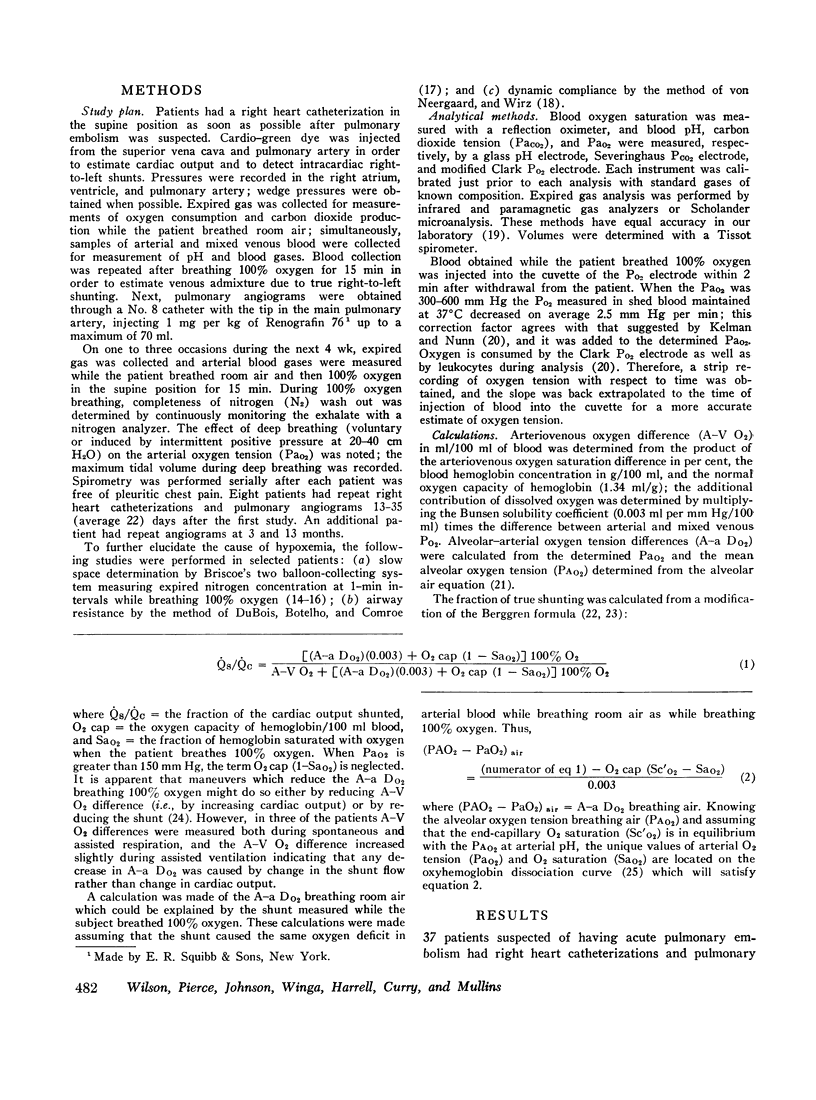
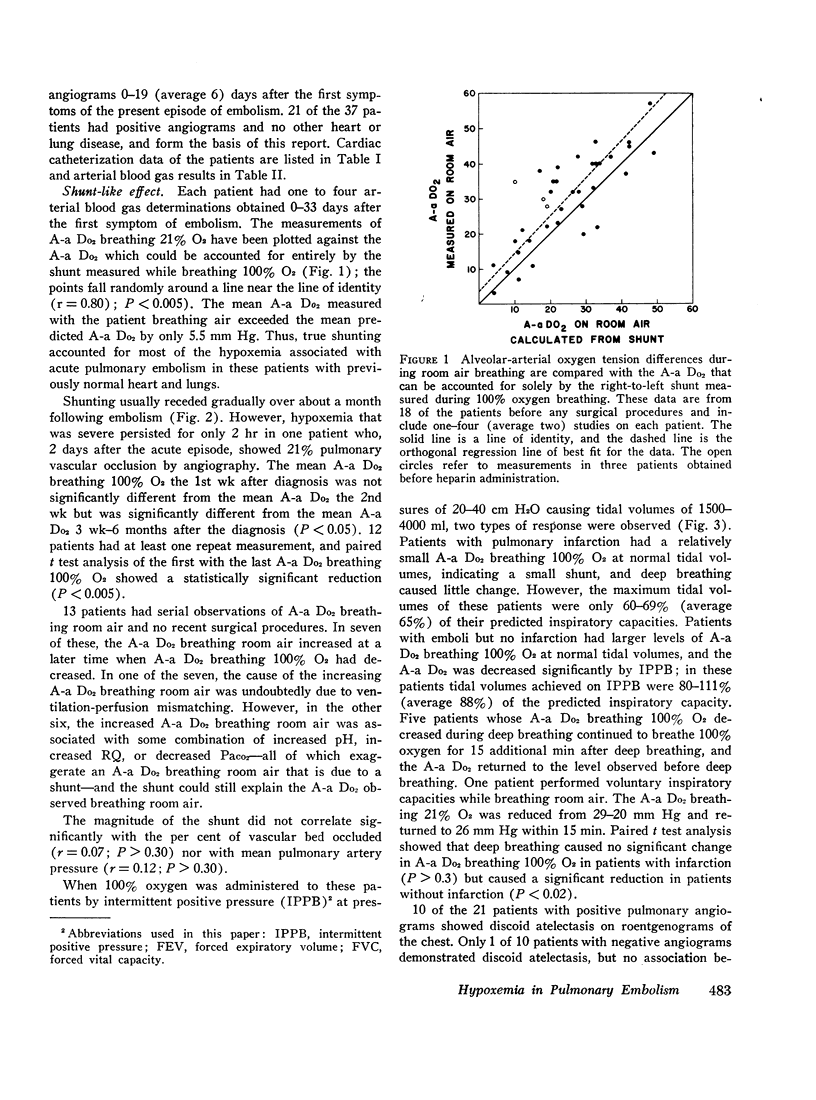

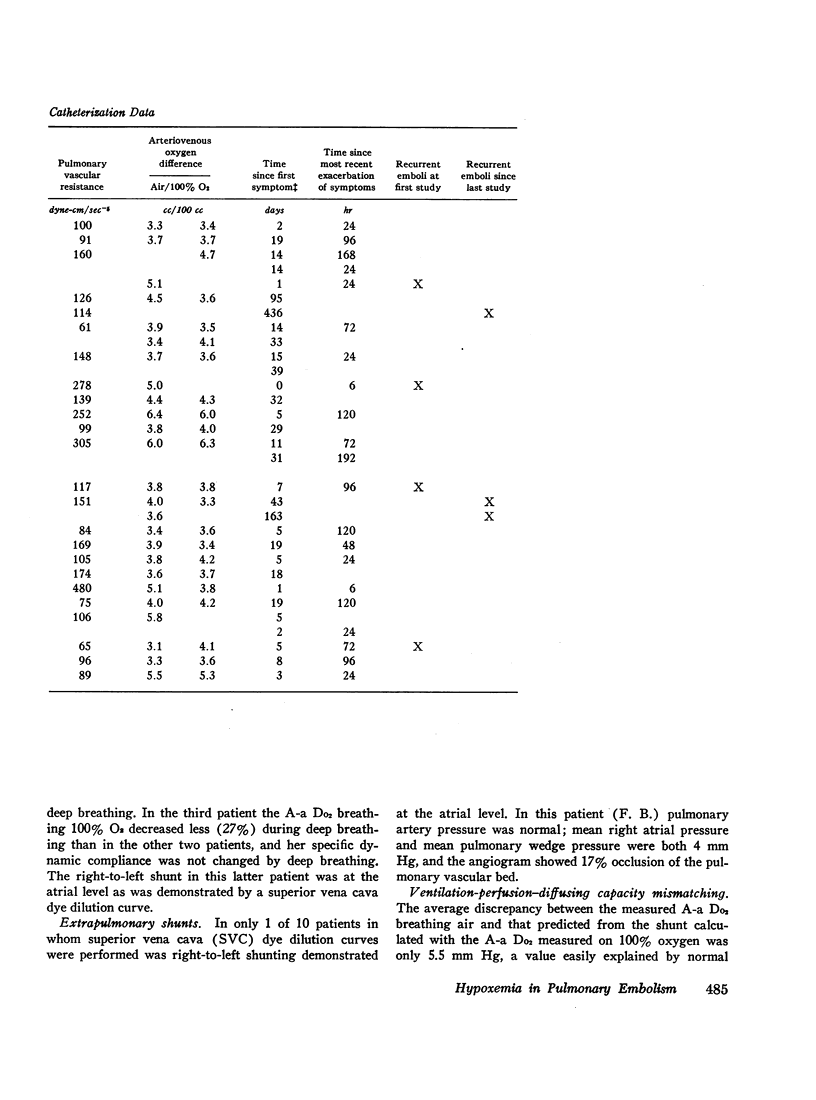
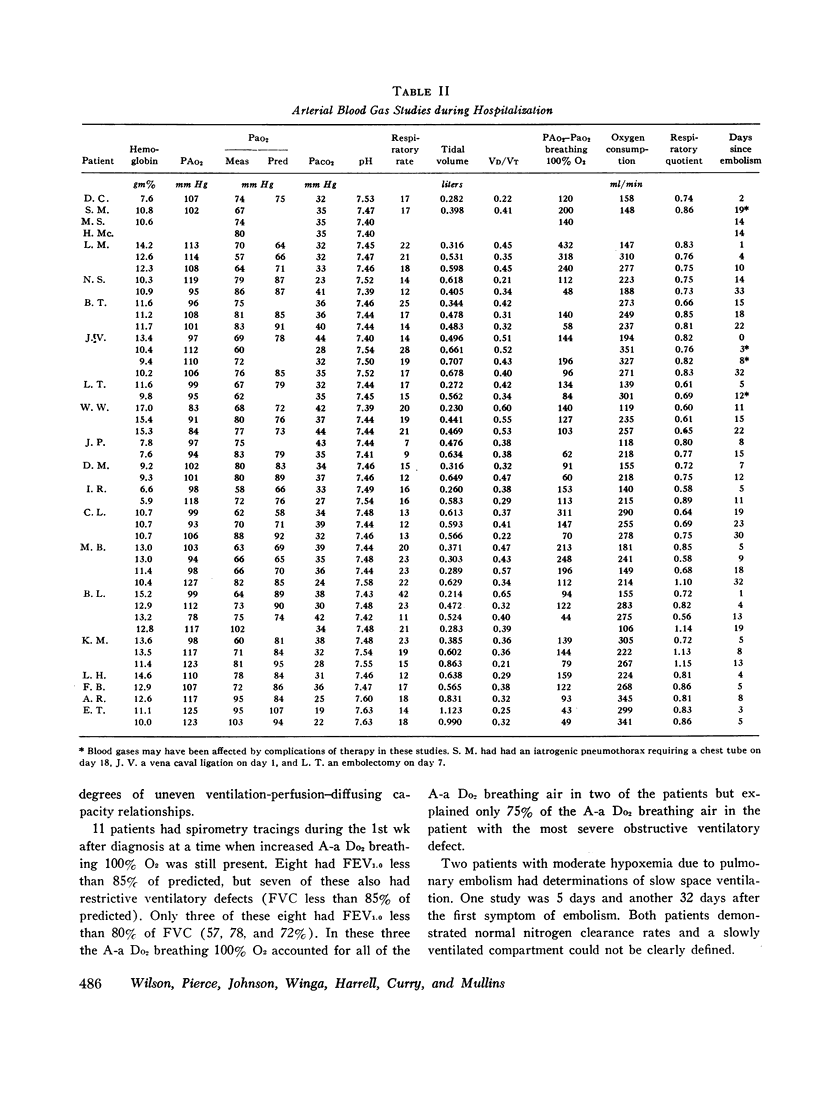
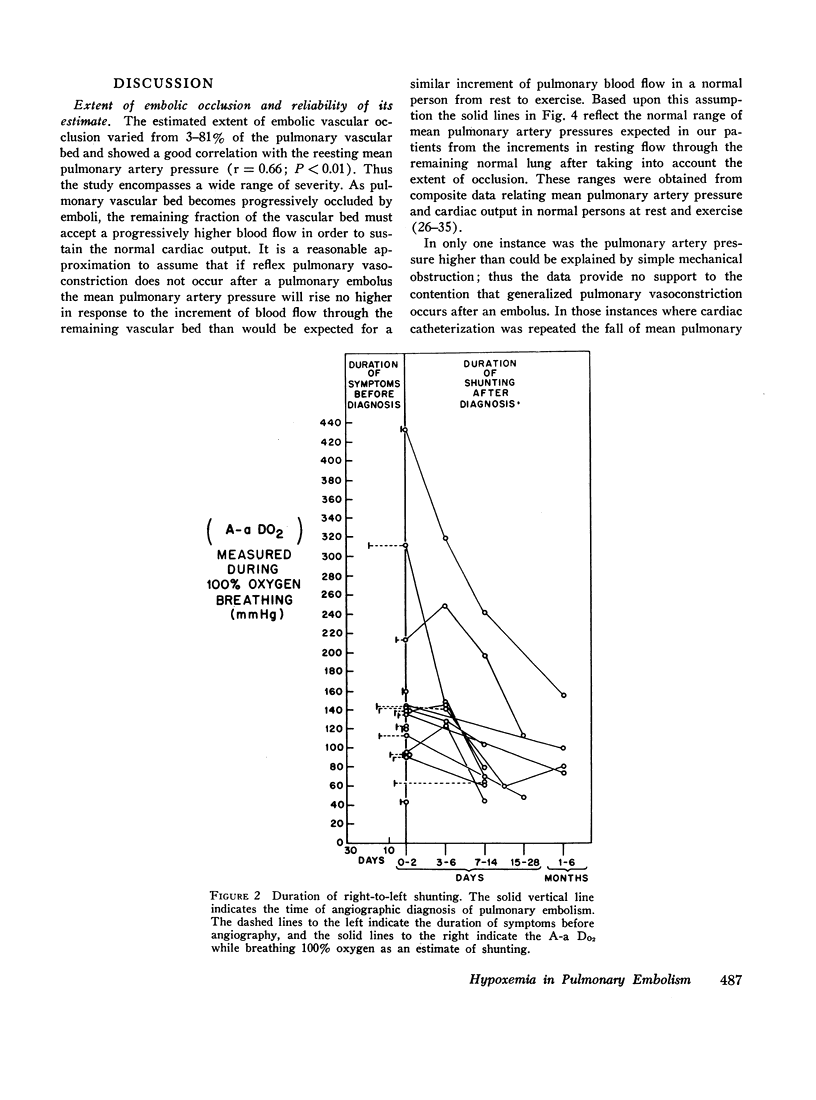

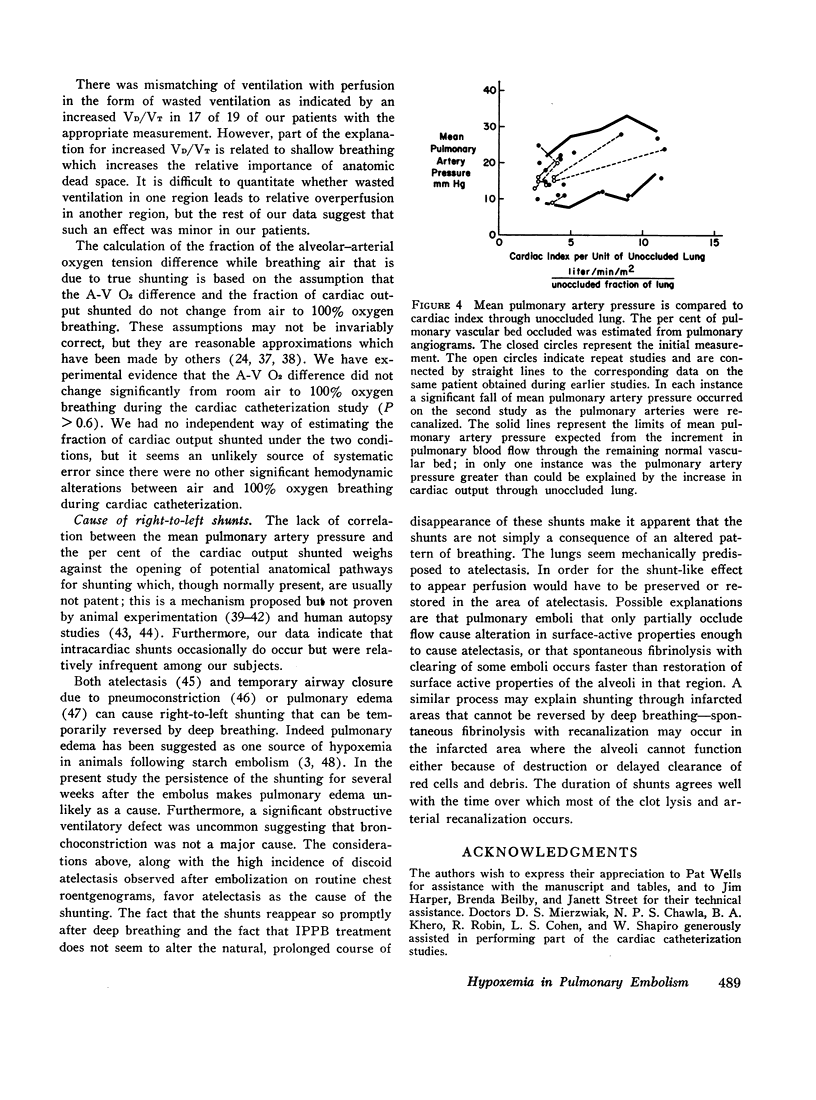
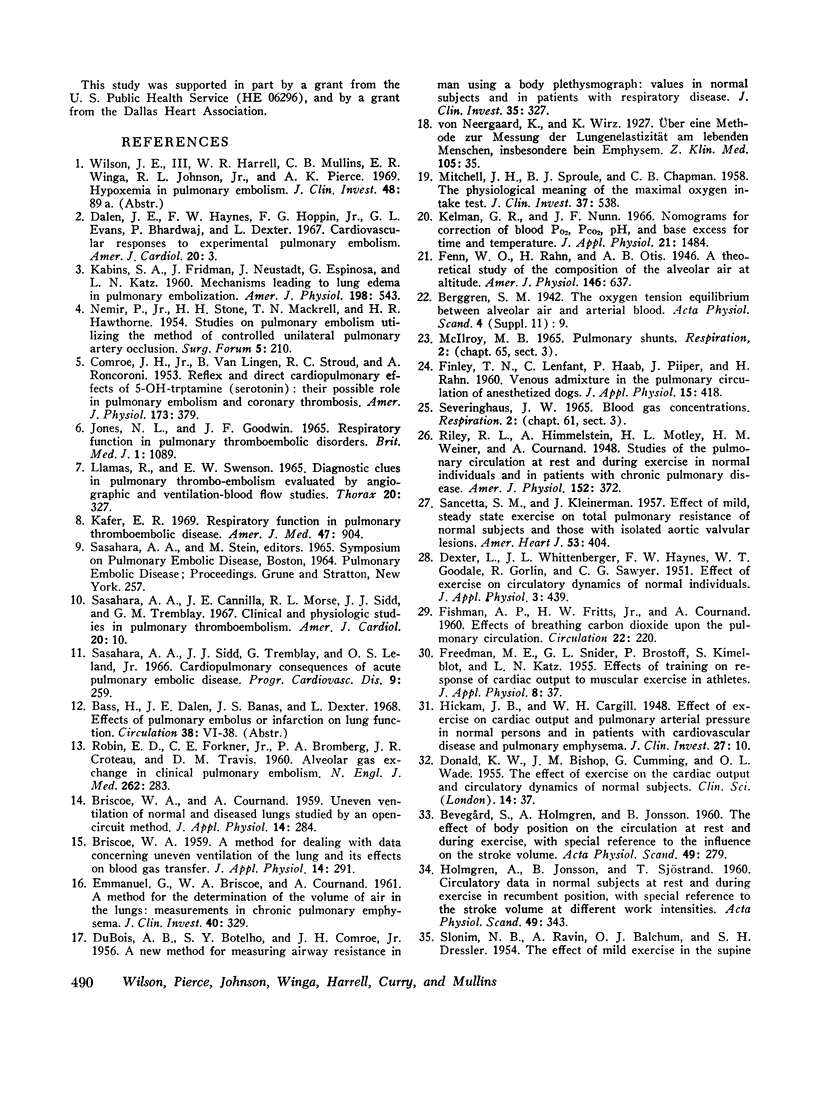
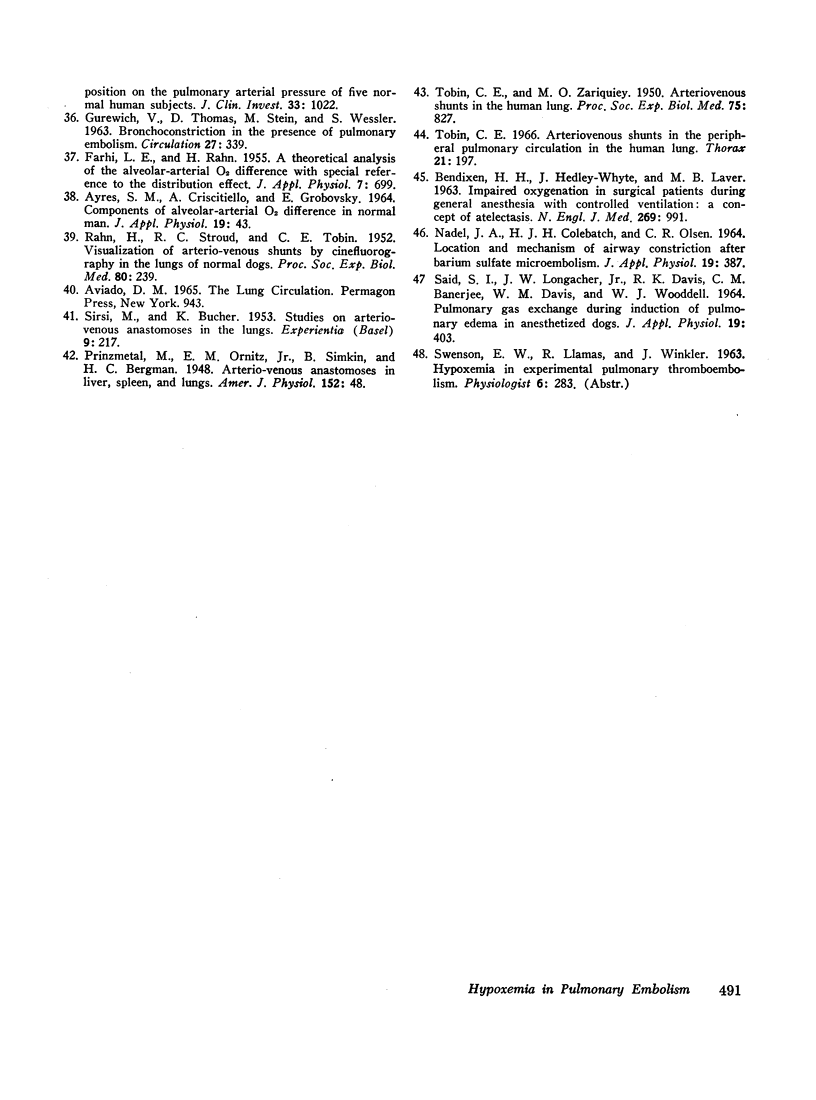
Selected References
These references are in PubMed. This may not be the complete list of references from this article.
- AYRES S. M., CRISCITIELLO A., GRABOVSKY E. COMPONENTS OF ALVEOLAR-ARTERIAL O2 DIFFERENCE IN NORMAL MAN. J Appl Physiol. 1964 Jan;19:43–47. doi: 10.1152/jappl.1964.19.1.43. [DOI] [PubMed] [Google Scholar]
- BENDIXEN H. H., HEDLEY-WHYTE J., LAVER M. B. IMPAIRED OXYGENATION IN SURGICAL PATIENTS DURING GENERAL ANESTHESIA WITH CONTROLLED VENTILATION. A CONCEPT OF ATELECTASIS. N Engl J Med. 1963 Nov 7;269:991–996. doi: 10.1056/NEJM196311072691901. [DOI] [PubMed] [Google Scholar]
- BEVEGARD S., HOLMGREN A., JONSSON B. The effect of body position on the circulation at rest and during exercise, with special reference to the influence on the stroke volume. Acta Physiol Scand. 1960 Jul 15;49:279–298. doi: 10.1111/j.1748-1716.1960.tb01953.x. [DOI] [PubMed] [Google Scholar]
- BRISCOE W. A. A method for dealing with data concerning uneven ventilation of the lung and its effects on blood gas transfer. J Appl Physiol. 1959 May;14(3):291–298. doi: 10.1152/jappl.1959.14.3.291. [DOI] [PubMed] [Google Scholar]
- BRISCOE W. A., COURNAND A. Uneven ventilation of normal and diseased lungs studied by an open-circuit method. J Appl Physiol. 1959 May;14(3):284–290. doi: 10.1152/jappl.1959.14.3.284. [DOI] [PubMed] [Google Scholar]
- COMROE J. H., Jr, VAN LINGEN B., STROUD R. C., RONCORONI A. Reflex and direct cardiopulmonary effects of 5-OH-tryptamine (serotonin); their possible role in pulmonary embolism and coronary thrombosis. Am J Physiol. 1953 Jun;173(3):379–386. doi: 10.1152/ajplegacy.1953.173.3.379. [DOI] [PubMed] [Google Scholar]
- DEXTER L., WHITTENBERGER J. L., HAYNES F. W., GOODALE W. T., GORLIN R., SAWYER C. G. Effect of exercise on circulatory dynamics of normal individuals. J Appl Physiol. 1951 Feb;3(8):439–453. doi: 10.1152/jappl.1951.3.8.439. [DOI] [PubMed] [Google Scholar]
- DUBOIS A. B., BOTELHO S. Y., COMROE J. H., Jr A new method for measuring airway resistance in man using a body plethysmograph: values in normal subjects and in patients with respiratory disease. J Clin Invest. 1956 Mar;35(3):327–335. doi: 10.1172/JCI103282. [DOI] [PMC free article] [PubMed] [Google Scholar]
- EMMANUEL G., BRISCOE W. A., COURNAND A. A method for the determination of the volume of air in the lungs: measurements in chronic pulmonary emphysema. J Clin Invest. 1961 Feb;40:329–337. doi: 10.1172/JCI104260. [DOI] [PMC free article] [PubMed] [Google Scholar]
- FARHI L. E., RAHN H. A theoretical analysis of the alveolar-arterial O2 difference with special reference to the distribution effect. J Appl Physiol. 1955 May;7(6):699–703. doi: 10.1152/jappl.1955.7.6.699. [DOI] [PubMed] [Google Scholar]
- FINLEY T. N., LENFANT C., HAAB P., PIIPER J., RAHN H. Venous admixture in the pulmonary circulation of anestethetized dogs. J Appl Physiol. 1960 May;15:418–424. doi: 10.1152/jappl.1960.15.3.418. [DOI] [PubMed] [Google Scholar]
- FISHMAN A. P., FRITTS H. W., Jr, COURNAND A. Effects of breathing carbon dioxide upon the pulmonary circulation. Circulation. 1960 Aug;22:220–225. doi: 10.1161/01.cir.22.2.220. [DOI] [PubMed] [Google Scholar]
- FREEDMAN M. E., SNIDER G. L., BROSTOFF P., KIMELBLOT S., KATZ L. N. Effect of training on response of cardiac output to muscular exercise in athletes. J Appl Physiol. 1955 Jul;8(1):37–47. doi: 10.1152/jappl.1955.8.1.37. [DOI] [PubMed] [Google Scholar]
- GUREWICH V., THOMAS D., STEIN M., WESSLER S. Bronchoconstriction in the presence of pulmonary embolism. Circulation. 1963 Mar;27:339–345. doi: 10.1161/01.cir.27.3.339. [DOI] [PubMed] [Google Scholar]
- HOLMGREN A., JONSSON B., SJOSTRAND T. Circulatory data in normal subjects at rest and during exercise in recumbent position, with special reference to the stroke volume at different work intensities. Acta Physiol Scand. 1960 Aug 25;49:343–363. doi: 10.1111/j.1748-1716.1960.tb01957.x. [DOI] [PubMed] [Google Scholar]
- Hickam J. B., Cargill W. H. EFFECT OF EXERCISE ON CARDIAC OUTPUT AND PULMONARY ARTERIAL PRESSURE IN NORMAL PERSONS AND IN PATIENTS WITH CARDIOVASCULAR DISEASE AND PULMONARY EMPHYSEMA. J Clin Invest. 1948 Jan;27(1):10–23. doi: 10.1172/JCI101912. [DOI] [PMC free article] [PubMed] [Google Scholar]
- JONES N. L., GOODWIN J. F. RESPIRATORY FUNCTION IN PULMONARY THROMBOEMBOLIC DISORDERS. Br Med J. 1965 Apr 24;1(5442):1089–1093. doi: 10.1136/bmj.1.5442.1089. [DOI] [PMC free article] [PubMed] [Google Scholar]
- KABINS S. A., FRIDMAN J., NEUSTADT J., ESPINOSA G., KATZ L. N. Mechanisms leading to lung edema in pulmonary embolization. Am J Physiol. 1960 Mar;198:543–546. doi: 10.1152/ajplegacy.1960.198.3.543. [DOI] [PubMed] [Google Scholar]
- Kafer E. R. Respiratory function in pulmonary thromboembolic disease. Am J Med. 1969 Dec;47(6):904–915. doi: 10.1016/0002-9343(69)90204-6. [DOI] [PubMed] [Google Scholar]
- Kelman G. R., Nunn J. F. Nomograms for correction of blood Po2, Pco2, pH, and base excess for time and temperature. J Appl Physiol. 1966 Sep;21(5):1484–1490. doi: 10.1152/jappl.1966.21.5.1484. [DOI] [PubMed] [Google Scholar]
- LLAMAS R., SWENSON E. W. DIAGNOSTIC CLUES IN PULMONARY THROMBO-EMBOLISM EVALUATED BY ANGIOGRAPHIC AND VENTILATION-BLOOD FLOW STUDIES. Thorax. 1965 Jul;20:327–336. doi: 10.1136/thx.20.4.327. [DOI] [PMC free article] [PubMed] [Google Scholar]
- MITCHELL J. H., SPROULE B. J., CHAPMAN C. B. The physiological meaning of the maximal oxygen intake test. J Clin Invest. 1958 Apr;37(4):538–547. doi: 10.1172/JCI103636. [DOI] [PMC free article] [PubMed] [Google Scholar]
- NADEL J. A., COLEBATCH J. H., OLSEN C. R. LOCATION AND MECHANISM OF AIRWAY CONSTRICTION AFTER BARIUM SULFATE MICROEMBOLISM. J Appl Physiol. 1964 May;19:387–394. doi: 10.1152/jappl.1964.19.3.387. [DOI] [PubMed] [Google Scholar]
- NEMIR P., Jr, STONE H. H., MACKRELL T. N., HAWTHORNE H. R. Studies on pulmonary embolism utilizing the method of controlled unilateral pulmonary artery occlusion. Surg Forum. 1955;5:210–214. [PubMed] [Google Scholar]
- RAHN H., STROUD R. C., TOBIN C. E. Visualization of arterio-venous shunts by cinefluorography in the lungs of normal dogs. Proc Soc Exp Biol Med. 1952 Jun;80(2):239–241. doi: 10.3181/00379727-80-19581. [DOI] [PubMed] [Google Scholar]
- ROBIN E. D., FORKNER C. E., Jr, BROMBERG P. A., CROTEAU J. R., TRAVIS D. M. Alveolar gas exchange in clinical pulmonary embolism. N Engl J Med. 1960 Feb 11;262:283–287. doi: 10.1056/NEJM196002112620604. [DOI] [PubMed] [Google Scholar]
- SAID S. I., LONGACHER J. W., Jr, DAVIS R. K., BANERJEE C. M., DAVIS W. M., WOODDELL W. J. PULMONARY GAS EXCHANGE DURING INDUCTION OF PULMONARY EDEMA IN ANESTHETIZED DOGS. J Appl Physiol. 1964 May;19:403–407. doi: 10.1152/jappl.1964.19.3.403. [DOI] [PubMed] [Google Scholar]
- SANCETTA S. M., KLEINERMAN J. Effect of mild, steady state exercise on total pulmonary resistance of normal subjects and those with isolated aortic valvular lesions. Am Heart J. 1957 Mar;53(3):404–414. doi: 10.1016/0002-8703(57)90175-8. [DOI] [PubMed] [Google Scholar]
- SIRSI M., BUCHER K. Studies on arteriovenous anastomoses in the lungs. Experientia. 1953 Jun;9(6):217–218. doi: 10.1007/BF02176896. [DOI] [PubMed] [Google Scholar]
- SLONIM N. B., RAVIN A., BALCHUM O. J., DRESSLER S. H. The effect of mild exercise in the supine position on the pulmonary arterial pressure of five normal human subjects. J Clin Invest. 1954 Jul;33(7):1022–1030. doi: 10.1172/JCI102969. [DOI] [PMC free article] [PubMed] [Google Scholar]
- Sasahara A. A., Cannilla J. E., Morse R. L., Sidd J. J., Tremblay G. M. Clinical and physiologic studies in pulmonary thromboembolism. Am J Cardiol. 1967 Jul;20(1):10–20. doi: 10.1016/0002-9149(67)90105-1. [DOI] [PubMed] [Google Scholar]
- Sasahara A. A., Sidd J. J., Tremblay G., Leland O. S., Jr Cardiopulmonary consequences of acute pulmonary embolic disease. Prog Cardiovasc Dis. 1966 Nov;9(3):259–274. doi: 10.1016/s0033-0620(66)80027-0. [DOI] [PubMed] [Google Scholar]
- TOBIN C. E., ZARIQUIEY M. O. Arteriovenous shunts in the human lung. Proc Soc Exp Biol Med. 1950 Dec;75(3):827–829. doi: 10.3181/00379727-75-18360. [DOI] [PubMed] [Google Scholar]
- Tobin C. E. Arteriovenous shunts in the peripheral pulmonary circulation in the human lung. Thorax. 1966 May;21(3):197–204. doi: 10.1136/thx.21.3.197. [DOI] [PMC free article] [PubMed] [Google Scholar]


